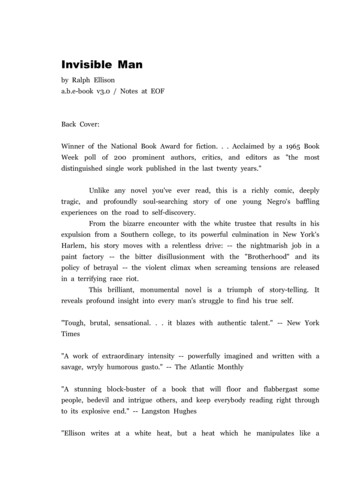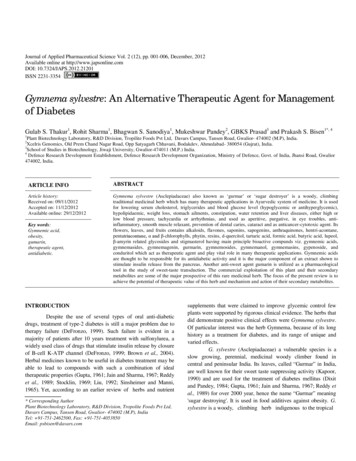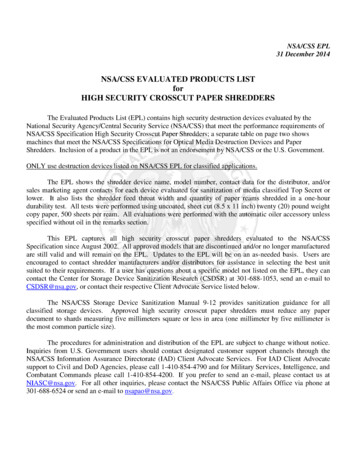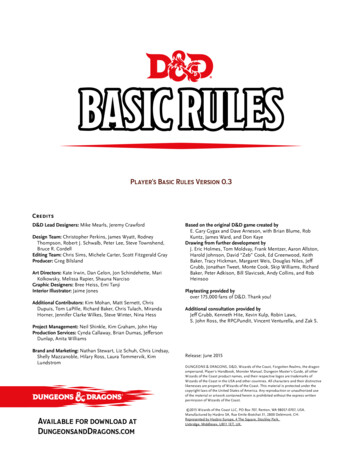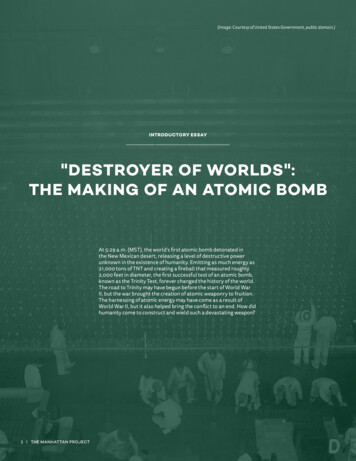
Transcription
(Image: Courtesy of United States Government, public domain.)INTRODUCTORY ESSAY"DESTROYER OF WORLDS":THE MAKING OF AN ATOMIC BOMBAt 5:29 a.m. (MST), the world’s first atomic bomb detonated inthe New Mexican desert, releasing a level of destructive powerunknown in the existence of humanity. Emitting as much energy as21,000 tons of TNT and creating a fireball that measured roughly2,000 feet in diameter, the first successful test of an atomic bomb,known as the Trinity Test, forever changed the history of the world.The road to Trinity may have begun before the start of World WarII, but the war brought the creation of atomic weaponry to fruition.The harnessing of atomic energy may have come as a result ofWorld War II, but it also helped bring the conflict to an end. How didhumanity come to construct and wield such a devastating weapon?1 THE MANHATTAN PROJECT
Models of Fat Man and Little Boy on display at the Bradbury Science Museum.(Image: Courtesy of Los Alamos National Laboratory.)WE WAITED UNTIL THE BLAST HAD PASSED, WALKED OUT OF THE SHELTER AND THEN IT WASENTIRELY SOLEMN. WE KNEW THE WORLD WOULD NOT BE THE SAME. A FEW PEOPLE LAUGHED, AFEW PEOPLE CRIED. MOST PEOPLE WERE SILENT.J. ROBERT OPPENHEIMEREARLY NUCLEAR RESEARCHGERMAN DISCOVERY OF FISSIONAchieving the monumental goal of splitting the nucleusof an atom, known as nuclear fission, came through thedevelopment of scientific discoveries that stretched over severalcenturies. Beginning in 1789, when German scientist MartinKlaproth discovered the dense, metallic element he calleduranium, exploration of atomic energy and radiation came tofascinate scientific minds. As Marie Curie was conducting hergroundbreaking research on uranium in the late nineteenthcentury, she found that the element was naturally radioactive.Curie created the term “radioactive” to describe the emissionof electromagnetic particles from disintegrating atoms. Curie’sdiscovery of radioactivity in elements forever changed thenature of atomic science. Building from this research, Britishphysicist Ernest Rutherford in 1911 formulated a model of theatom in which low-mass electrons orbited a charged nucleusthat contained the bulk of the atom’s mass.The 1930s saw further development in the field. HungarianGerman physicist Leo Szilard conceived the possibility of selfsustaining nuclear fission reactions, or a nuclear chain reaction,in 1933. The following year, Italian physicist Enrico Fermiunknowingly split neutrons within uranium while conducting hisown experiments. On the heels of these developments, AustrianSwedish physicist Lise Meitner, working with German chemistOtto Hahn, was among the first to achieve the successful fissionof uranium. However, the anti-Semitism of the Nazi party forcedMeitner, who was Jewish, to flee and settle in Sweden. Whilein Sweden, Meitner identified and named the process ofnuclear fission.THE MANHATTAN PROJECT 2
"DESTROYER OF WORLDS": THE MAKING OF AN ATOMIC BOMBMeitner’s findings became a tipping point in the developmentof nuclear weapons, but as the world once more moved intowar, it was the Germans who held the potential key to nuclearpower. While Hahn chose to remain in Germany and continuedto develop his research throughout World War II, scientistsacross Europe steadily fled. Szilard, a Jewish man, migrated tothe United States in 1938 to avoid persecution. Fermi and hiswife, Laura Capon, also left Europe at the end of 1938 to escapegrowing Fascism in Italy. Capon, who was also Jewish, traveledwith Fermi to New York City where both applied forpermanent residency.THE UNITED STATES TAKES ACTIONWhen news of Hahn and Meitner’s discovery of fission reachedSzilard in his New York City home in early 1939, Szilard beganwork to confirm their findings. Szilard found help in collaboratorWalter Zinn, and together they recreated Hahn’s experiment.Recognizing the significance of that moment, Szilard stated,“That night, there was very little doubt in my mind that theworld was headed for grief.” Szilard began to work with Fermi toconstruct a nuclear reactor at Columbia University, but as theydid so, Szilard feared that scientists in Germany, who were aidingthe Nazi war effort, were similarly constructing theirown reactors.In July 1939, Szilard contacted the prominent Jewish Germantheoretical physicist Albert Einstein at his home on Long Island,New York, to discuss German advances in nuclear development.Together, Szilard and Einstein drafted a letter to US PresidentFranklin D. Roosevelt. In the letter, dated August 2, 1939, thewarning was clear: “This new phenomenon would also lead tothe construction of bombs, and it is conceivable — though muchless certain — that extremely powerful bombs of a new type maythus be constructed.” The letter did not reach Roosevelt untilOctober, but once he learned of the potential risks presentedby nuclear weaponry, he responded by forming the AdvisoryCommittee on Uranium, which held its first meeting onOctober 21, 1939.THE MANHATTAN PROJECTOverhead shot of Fermi's Pile-1 experiment constructed beneathStagg Field the University of Chicago.(Image: Courtesy of Los Alamos National Laboratory.)District, named for the location of its offices in New York City.The following month, on September 17, Colonel Leslie R. Groveswas appointed to head the project and received a promotion toBrigadier General. Within two days of his appointment, Grovesmade quick decisions to move the project forward, selectingthree primary sites for the manufacture of an atomic bomb.Although formed in 1939, the Advisory Committee on Uraniummoved slowly at first. However, Japan’s attack on Pearl Harboron December 7, 1941, pushed the Committee into action. Withthe United States formally at war, the question of uraniumdevelopment and the potential construction of an atomic bombgained renewed interest. This interest rose even higher as areport issued by British scientists in March 1941 confirmed thepossibility of building a uranium-based bomb, giving Americanscientists the validation they sought. In spite of this enthusiasm,the limitation of resources quickly became evident andprompted committee leaders to turn to the military for help.Groves first selected Oak Ridge, Tennessee, as the site foruranium enrichment. Also among the primary project sites wasLos Alamos, New Mexico. Designated “Project Y,” Los Alamoswas the site of the Manhattan Project’s weapons researchlaboratory. This Los Alamos site would become the locationfor the construction of the atomic bombs. The last primary siteGroves selected was Hanford, Washington, which he designatedto produce plutonium from the uranium isotope U-238. Thoughplutonium is not a naturally occurring element, scientistsdiscovered its production within uranium reactors. Plutoniumproved to be a more radioactive metal and had a higherpossibility of achieving nuclear fission.As the United States began its island-hopping campaign inthe Pacific, the Army Corps of Engineers took over the effortto produce atomic weaponry on the Home Front. On August13, 1942, the Army Corps created the Manhattan EngineerAs Groves made these moves, a breakthrough in nuclearresearch beneath the squash courts at the University of Chicagocreated a model for the future production of atomic weapons.3 THE MANHATTAN PROJECT
"DESTROYER OF WORLDS": THE MAKING OF AN ATOMIC BOMBEarly in 1942, Fermi and Szilard, who had been working to builda reactor at the University of Columbia, moved their effort toChicago. After construction was complete, on December 2 ofthat year, the scientists began removing the calcium controlrods from the uranium pile. Following the removal of thefinal control rod, the pile went critical. The resulting nuclearreaction became self-sustaining and continued at an increasingpace for a few minutes until Fermi ordered the reactor shut off.Although the reaction only produced enough energy to powera light bulb, this moment marked the first instance in history ofa self-sustaining nuclear reaction. The event also gave nuclearscientists a model for the production of large amounts ofplutonium, which would eventually become the basis of theB Reactor built at Hanford.After receiving formal approval from President Roosevelt onDecember 28, 1942, the Manhattan Project developed into amassive undertaking that spread across the United States. Withover 30 project sites and over 100,000 workers, the ManhattanProject came to cost approximately 2.2 billion. Even thoughencompassing such a massive scale, the project largely remaineda secret, and many of the people working on the constructionof the atomic bomb did not fully know the purpose behind theirjobs. Following Fermi’s successful experiment in Chicago, thereappeared to be two possible paths toward building atomicbombs: uranium and plutonium. The Manhattan Project builtboth kinds of bombs, ultimately resulting in the constructionof Little Boy, a gun-method uranium bomb, and Fat Man, animplosion-method plutonium bomb.The responsibility of bringing these bombs into existencefell to the man Groves selected to head the secret weaponslaboratory at Los Alamos: J. Robert Oppenheimer. A theoreticalphysicist and professor of physics at the University ofCalifornia, Berkeley, Oppenheimer became involved early inthe scientific research that ultimately led to the ManhattanProject. Under Oppenheimer’s direction, Manhattan Projectworkers constructed a plutonium bomb. The plutonium bombrelied upon the implosion of the reactive plutonium ratherthan on the piercing of the plutonium with a bullet, which wascommon in gun-method bombs and which worked better withuranium. While the gun-method was a more familiar methodconceptually to its creators, the implosion-method was not.Due to the unprecedented nature of such a bomb, Oppenheimerfelt a test was necessary. Groves initially hesitated becauseplutonium was both expensive and rare. However, Grovesrelented and approved moving forward with a test.THE STUFF WILL APPARENTLY BE MOREPOWERFUL THAN WE THOUGHT, THE AMOUNTNECESSARY APPEARS TO BE LESS, THEPOSSIBILITIES OF ACTUAL PRODUCTIONAPPEAR MORE CERTAIN.VANNEVAR BUSH TO PRESIDENT ROOSEVELT, MARCH 9, 1942Front face of the B Reactor at the Manhattan Project site in Hanford, WA.(Image: Courtesy of United States Government, public domain.)THE MANHATTAN PROJECT 4
Expanding explosion from the Trinity Test in Alamogordo, New Mexico.(Image: The National WWII Museum, 2012.019.741 1.)5 THE MANHATTAN PROJECT
"DESTROYER OF WORLDS": THE MAKING OF AN ATOMIC BOMBNOW I AM BECOME DEATH,THE DESTROYER OF WORLDS.J. ROBERT OPPENHEIMER REFERENCINGA VERSE FROM THE BHAGAVAD GITA.THE TRINITY TESTInspired by the seventeenth-century poet, John Donne,Oppenheimer came to call the test “Trinity.” Oppenheimer hadbeen reading Donne’s Holy Sonnets before the test and foundinspiration in the line from “Sonnet XIV,” which opens withthe line, “Batter my heart, three-person'd God.” The test tookplace at Alamogordo, New Mexico, rather than at Los Alamos.Hundreds of Manhattan Project workers moved in to preparethe Alamogordo site which was located 200 miles south of theProject Y site. The test bomb, nicknamed Gadget, contained13 pounds of plutonium, as well as the implosion-method ofdetonation. Using a steel tower, scientists hoisted and suspendedGadget 100 feet into the air, and at 5:29 a.m. on July 16, 1945,the Trinity Test began. The test proved far more successfulthan Oppenheimer anticipated. He had expected an explosionequivalent to .3 kilotons of TNT; instead, the resulting blastequated to roughly 21 kilotons of TNT. The flash from the bombwas so bright that it temporarily blinded observers standing10,000 yards away. The heat from the bomb was so intense thatit evaporated the steel tower, left a crater five feet deep by 30feet wide, and melted the sand in the area, creating a mildlyradioactive green glass called “trinitite.” Upon witnessing theblast, Oppenheimer famously uttered a line from the BhagavadGita, “Now I am become Death, the destroyer of worlds.”CONCLUSIONThe success of the Trinity Test exceeded the expectations ofGroves and most of the scientists involved in the ManhattanProject. The day after the test, Roosevelt’s successor, PresidentHarry Truman, traveled to the Potsdam Conference where hereceived word of the Trinity Test’s success. Truman used theresults as leverage to demand Japan’s unconditional surrender,which Japanese officials opted to ignore. The discovery andharnessing of atomic energy not only served to bring World WarII to a rapid and fiery end, but it also placed the United States ina position of global power not held by any other nation followingthe war’s end. From the race to keep such power out of Nazihands and to the use of atomic bombs on Japan to end the war,the Manhattan Project pushed humanity across the thresholdinto a new atomic age that forever altered the nature of conflictand the fear of global warfare.The B-29 bomber, Bockscar, flies over Nagasaki as a mushroom cloud risesin the background.(Image: Courtesy of Los Alamos National Laboratory.)THE MANHATTAN PROJECT 6
At 5:29 a.m. (MST), the world's first atomic bomb detonated in the New Mexican desert, releasing a level of destructive power unknown in the existence of humanity. Emitting as much energy as 21,000 tons of TNT and creating a fireball that measured roughly 2,000 feet in diameter, the first successful test of an atomic bomb,



